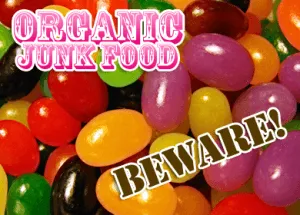Walk down the aisles of a natural food store and you’ll find a variety of organic foods, many of which are healthy whole foods, such as organic fruits, vegetables, grains, beans, dairy products, nuts, and seeds.

“Organic is on so many food packages of highly processed foods,” says Andrea Giancoli, M.P.H., R.D., dietitian and spokesperson for the Academy of Nutrition and Dietetics, Washington, D.C. “I find that people see ‘organic’ on a food label and it doesn’t seem to matter what the actual food is; they think it is healthful.”
“Organic means that the food is farmed in a different way, which is great for the planet, but that doesn’t mean it’s always better for you,” says Giancoli. If you see “organic” on the food label for chocolate chip cookies, all it means is that the ingredients, such as wheat, sugar, chocolate, and butter, are cultivated organically. It doesn’t mean that the nutrition profile of calories, fat, sugar, and sodium in those cookies is any better than the regular chocolate chip cookies across the aisle.
Giancoli explains that many organic junk foods are made of highly processed ingredients such as refined white flour, sugars, salt, and oils, offering you a great deal of calories and sodium with little nutrient payback.
“A cookie is a cookie; it doesn’t matter if it’s organic,” she adds.
Ironically, highly processed foods–organic or not–are in complete opposition to the philosophy behind eco-friendly foods with a minimal carbon footprint. Such highly processed ingredients require more resources to process, manufacture, and distribute than simple whole foods, like an apple or head of broccoli, especially if they’re grown locally.
READ THE LABEL
How can you tell whether an organic food is a wise choice worthy of the extra price? Read those food labels.
“The most important information on a food label is not on the front–that’s mostly advertisement. It’s on the back and side panel of the package: the nutrition facts label and ingredients list,” says Giancoli. The nutrition facts label will tell you levels of calories, saturated fat, sugar, or sodium, as well as important nutrients such as protein, fiber, and some vitamins and minerals.
The ingredient list includes all food ingredients in descending order by weight–if you see highly refined ingredients, such as white flour, white rice and sugar appear high up on the list, the product is probably a highly processed food.
“For example, organic crackers can be made with processed flours. Look at the ingredients; if the first ingredient isn’t a whole grain, it’s not worth it,” says Giancoli. She also advises keeping an eye out for added sugars in organic foods; even if the food contains organic brown rice syrup or evaporated cane juice, it’s just another name for sugar. Organic foods to watch out for include sweetened beverages, crackers, candy bars, candy, energy bars, and chips that are high in calories, but offer little nutrient reward.
“They’re just organic junk foods,” says Giancoli.
Make your organics count. If you are an organic consumer, the most effective–and healthy–way to spend your organic dollars is on true winners: whole plant foods, such as fruits, vegetables, grains, legumes, and nuts. These foods are rich in nutrients, such as protein, fiber, vitamins, minerals, and phytochemicals (naturally occurring plant compounds that protect health,) and low in calories, sugar, and saturated fat.
“Try to choose foods as close to the way they come out of the ground,” says Giancoli.
THE MEANING OF ORGANIC
The U.S. Department of Agriculture’s National Organic Program sets forth strict guidelines for the agriculture of organic foods, restricting the use of synthetic pesticides, fertilizers, and growth hormones; antibiotics, and genitically modified organisms in their production.
Thus, organic food production offers many bonuses to both people and the environment, such as lowering human exposure to these agents, as well as promoting healthy soil, ecosystems, and water supplies. However, these organic standards have nothing to do with regulating a food product’s nutritional attributes.
SMART ORGANIC FOOD SWAPS
1. Instead of organic sugar-sweetened breakfast cereal, choose organic steel cut oats.
2. Instead of organic candy, choose organic dried fruit, such as raisins, apricots, apples, cherries and berries.
3. Instead of organic potato chips, choose organic nuts and seeds, such as walnuts, pecans, pistachios, almonds and sunflower seeds.
4. Instead of organic soda, choose home-brewed organic iced tea.
5. Instead of butter crackers, choose organic whole wheat flatbread.
6. Instead of organic sandwich cookies, choose organic unsweetened fruit (fresh, canned or frozen), such as pears, apples, bananas, peaches, grapes and berries.
– Sharon Palmer R.D.
As a registered dietitian with 16 years of health care experience, she focuses on writing features covering health, wellness, nutrition, cooking, wine, restaurant reviews, and entertainment. Over 750 of Sharon’s features have been published in a variety of publications. Her recent book The Plant-Powered Diet: The Lifelong Eating Plan for Achieving Optimal Health, Beginning Today can be ordered here.

